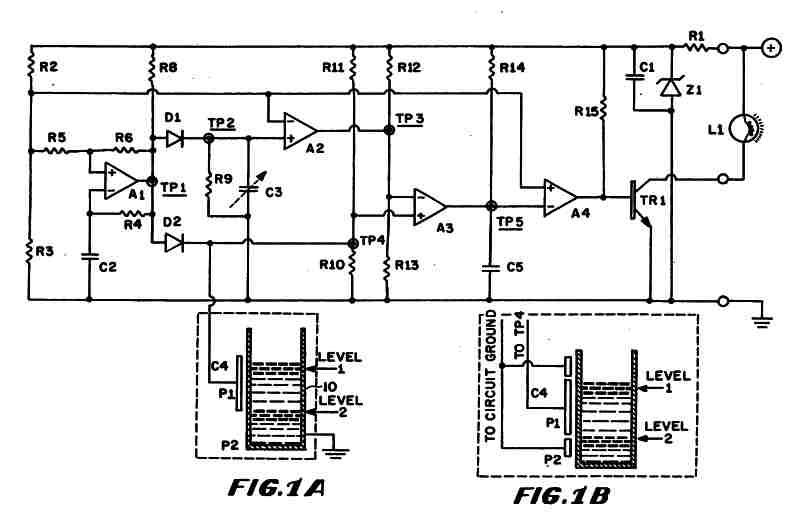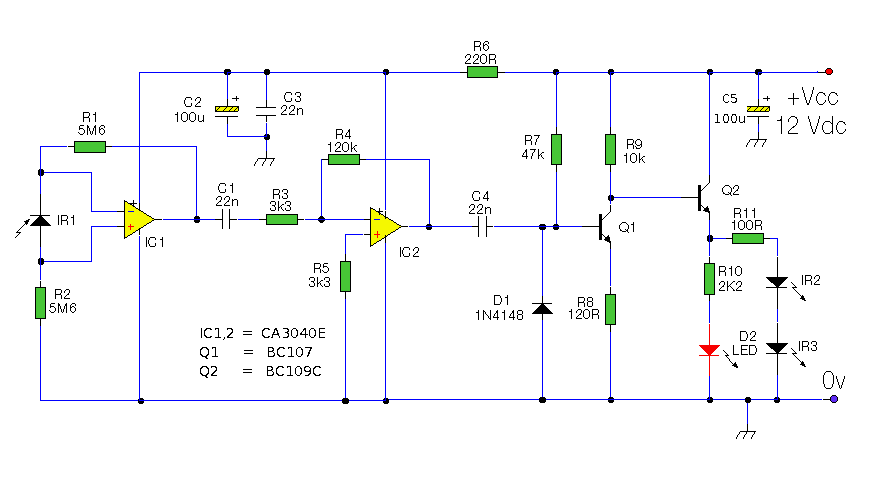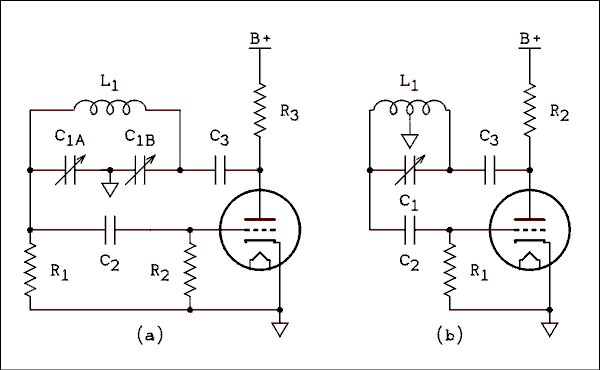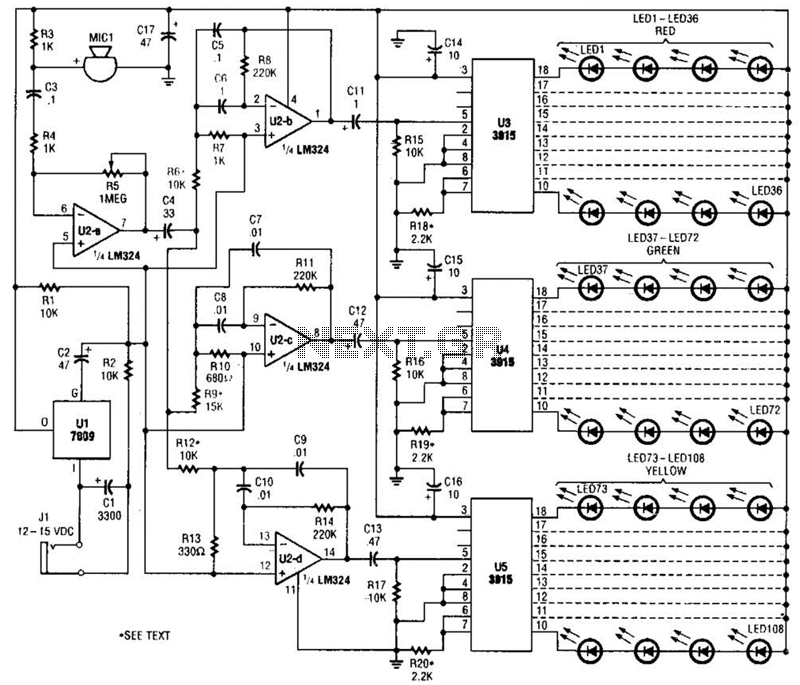
555 capacitor filter circuit diagrams
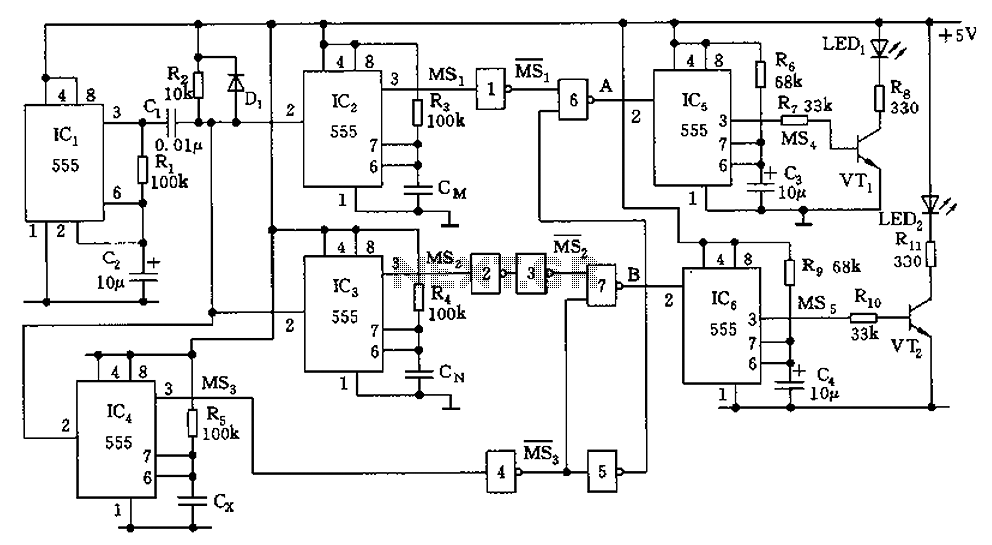
The capacitor filter operates by measuring the capacitance, which is proportional to the pulse width. This measurement is compared to a nominal capacitance to determine qualification. The circuit, as illustrated in the accompanying figure, includes IC1 along with resistors R1 and capacitor C2, forming an astable multivibrator that generates a square wave pulse with a period of approximately 1.4 seconds. IC2, IC3, and IC4 function as the core components of a monostable trigger circuit, where the timing of the trigger pulse width is determined by their respective charge and discharge time constants. Cx represents the capacitance being measured, while Cm and Cn denote the capacitance values of the upper and lower limits of the qualified capacitor. The relationship is defined as Cm < Cx < Cn. The output square wave from IC1 triggers IC2, IC3, and IC4, producing varying pulse widths that are compared in a comparator circuit. This comparison then triggers the monostable circuits IC5 and IC6. The NAND gates 6 and 7 output negative pulses; if no negative output is present, the 555 timer will not be activated, resulting in pin 3 being low. Consequently, transistors VT1 and VT2 remain off, and LEDs LED1 and LED2 do not illuminate, indicating that the capacitor under test is qualified. If LED1 flashes, it indicates that Cx is greater than Cm; conversely, if LED2 flashes, it indicates that Cx is less than Cn, signifying an overrun in capacitance. IC5 and IC6 generate one-shot pulses lasting approximately 0.8 seconds.
The described circuit utilizes an astable multivibrator configuration to generate a square wave that serves as a timing reference for the subsequent monostable circuits. The astable multivibrator, composed of IC1, R1, and C2, continuously oscillates, resulting in a periodic output that is essential for triggering the monostable circuits (IC2, IC3, IC4). These monostable circuits respond to the square wave output by generating a single output pulse whose width is contingent upon the charging and discharging characteristics of their respective capacitors.
The measured capacitance (Cx) is compared against predefined limits (Cm and Cn). The circuit effectively determines if the measured capacitance falls within acceptable bounds. If Cx exceeds Cm, LED1 activates, signaling that the capacitance is above the minimum threshold. Conversely, if Cx is lower than Cn, LED2 activates, indicating that the capacitance exceeds the maximum threshold. The NAND gates serve as a logical check to ensure that the output conditions are met before allowing the 555 timer to set, thus controlling the overall operation and indicating the status of the capacitor being tested.
In conclusion, this circuit provides a robust solution for capacitance measurement and qualification, utilizing standard IC components to achieve the desired functionality. The use of visual indicators (LEDs) enables easy interpretation of the test results, while the design ensures reliability and precision in capacitance evaluation. Capacitor filter works by the capacitance being measured is proportional to the pulse width and pulse width qualifying nominal capacitance comparing screening to detect. Circui t shown in Figure, IC1 and R1, C2 composition astable multivibrator, a period of about 1.4 seconds to produce a square wave pulse. In IC2, IC3, IC4 as the core component monostable trigger circuit, the timing of the trigger pulse width depending on their charge and discharge time constants.
Cx is measured capacitance, Cm, Cn is qualified capacitor capacitance of the upper and lower limit. That Cm Cx Cn. IC2, IC3, IC4 by IC1 output with square wave trigger, resulting in their different width, comparing the door circuit. Then trigger IC5, IC6 monostable circuit, the NAND gate 6,7 if not negative output pulses, 555 will not be set, 3 feet was low, VT1, VT2 off, LED1, LED2 are not light indicating that the capacitor under test qualified.
If LED1 luminous flash indicating Cx is greater than Cm; if LED2 luminous flash indicating that less than Cx Cn, capacity overrun. IC5, IC6 one-shot pulse generating about 0.8 seconds.
The described circuit utilizes an astable multivibrator configuration to generate a square wave that serves as a timing reference for the subsequent monostable circuits. The astable multivibrator, composed of IC1, R1, and C2, continuously oscillates, resulting in a periodic output that is essential for triggering the monostable circuits (IC2, IC3, IC4). These monostable circuits respond to the square wave output by generating a single output pulse whose width is contingent upon the charging and discharging characteristics of their respective capacitors.
The measured capacitance (Cx) is compared against predefined limits (Cm and Cn). The circuit effectively determines if the measured capacitance falls within acceptable bounds. If Cx exceeds Cm, LED1 activates, signaling that the capacitance is above the minimum threshold. Conversely, if Cx is lower than Cn, LED2 activates, indicating that the capacitance exceeds the maximum threshold. The NAND gates serve as a logical check to ensure that the output conditions are met before allowing the 555 timer to set, thus controlling the overall operation and indicating the status of the capacitor being tested.
In conclusion, this circuit provides a robust solution for capacitance measurement and qualification, utilizing standard IC components to achieve the desired functionality. The use of visual indicators (LEDs) enables easy interpretation of the test results, while the design ensures reliability and precision in capacitance evaluation. Capacitor filter works by the capacitance being measured is proportional to the pulse width and pulse width qualifying nominal capacitance comparing screening to detect. Circui t shown in Figure, IC1 and R1, C2 composition astable multivibrator, a period of about 1.4 seconds to produce a square wave pulse. In IC2, IC3, IC4 as the core component monostable trigger circuit, the timing of the trigger pulse width depending on their charge and discharge time constants.
Cx is measured capacitance, Cm, Cn is qualified capacitor capacitance of the upper and lower limit. That Cm Cx Cn. IC2, IC3, IC4 by IC1 output with square wave trigger, resulting in their different width, comparing the door circuit. Then trigger IC5, IC6 monostable circuit, the NAND gate 6,7 if not negative output pulses, 555 will not be set, 3 feet was low, VT1, VT2 off, LED1, LED2 are not light indicating that the capacitor under test qualified.
If LED1 luminous flash indicating Cx is greater than Cm; if LED2 luminous flash indicating that less than Cx Cn, capacity overrun. IC5, IC6 one-shot pulse generating about 0.8 seconds.
Warning: include(partials/cookie-banner.php): Failed to open stream: Permission denied in /var/www/html/nextgr/view-circuit.php on line 713
Warning: include(): Failed opening 'partials/cookie-banner.php' for inclusion (include_path='.:/usr/share/php') in /var/www/html/nextgr/view-circuit.php on line 713


